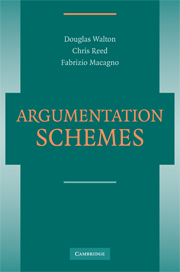Book contents
- Frontmatter
- Contents
- Acknowledgments
- Introduction
- 1 Basic Tools in the State of the Art
- 2 Schemes for Argument from Analogy, Classification, and Precedent
- 3 Knowledge-Related, Practical, and Other Schemes
- 4 Arguments from Generally Accepted Opinions, Commitment, and Character
- 5 Causal Argumentation Schemes
- 6 Schemes and Enthymemes
- 7 Attack, Rebuttal, and Refutation
- 8 The History of Schemes
- 9 A User's Compendium of Schemes
- 10 Refining the Classification of Schemes
- 11 Formalizing Schemes
- 12 Schemes in Computer Systems
- Bibliography
- Index
12 - Schemes in Computer Systems
Published online by Cambridge University Press: 05 June 2012
- Frontmatter
- Contents
- Acknowledgments
- Introduction
- 1 Basic Tools in the State of the Art
- 2 Schemes for Argument from Analogy, Classification, and Precedent
- 3 Knowledge-Related, Practical, and Other Schemes
- 4 Arguments from Generally Accepted Opinions, Commitment, and Character
- 5 Causal Argumentation Schemes
- 6 Schemes and Enthymemes
- 7 Attack, Rebuttal, and Refutation
- 8 The History of Schemes
- 9 A User's Compendium of Schemes
- 10 Refining the Classification of Schemes
- 11 Formalizing Schemes
- 12 Schemes in Computer Systems
- Bibliography
- Index
Summary
Argumentation theory has laid foundations for and has had influence upon a wide variety of computational systems (Reed and Norman, 2003). This chapter explores four distinct areas, reviewing the ways in which argumentation schemes have been put to work: in natural language generation, in interagent communication, in automated reasoning, and in various specific computational applications. To start, however, we look at the tools that are being used to support the development of these applications and that allow the creation, analysis, and manipulation of the raw computational resources that involve argumentation schemes.
SCHEMES IN ARAUCARIA
Following work examining the diagramming of natural argument – an important topic from the practical, pedagogic point of view (van Gelder and Rizzo, 2001), but also a driver of theoretical development in informal logic (Walton & Reed, 2004) – Reed and Rowe (2004) developed Araucaria, a system for aiding human analysts and students in marking up argument. Araucaria adopts the “standard treatment” (Freeman, 1991) for argument analysis, based on identification of propositions (as vertices in a diagram) and the relationships of support and attack holding between them (edges in a diagram). It is thus similar to a range of argument visualization tools (see Kirschner et al., 2003, for an overview), and familiar from AI techniques such as Pollock's (1995) inference graphs and even Bayesian nets and qualitative probabilistic networks.
- Type
- Chapter
- Information
- Argumentation Schemes , pp. 393 - 416Publisher: Cambridge University PressPrint publication year: 2008



